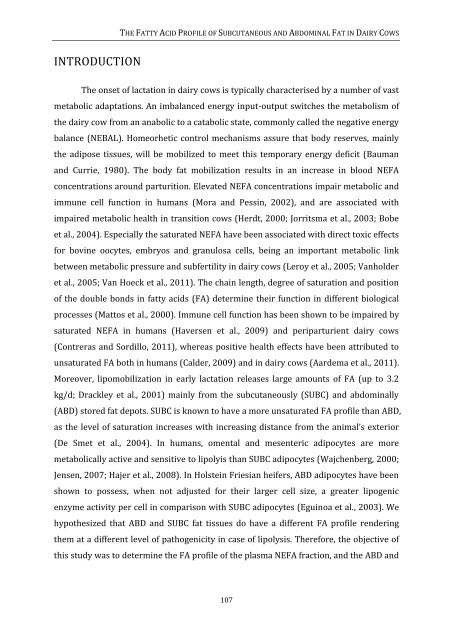view - Department of Reproduction, Obstetrics and Herd Health
view - Department of Reproduction, Obstetrics and Herd Health
view - Department of Reproduction, Obstetrics and Herd Health
You also want an ePaper? Increase the reach of your titles
YUMPU automatically turns print PDFs into web optimized ePapers that Google loves.
THE FATTY ACID PROFILE OF SUBCUTANEOUS AND ABDOMINAL FAT IN DAIRY COWS<br />
INTRODUCTION<br />
The onset <strong>of</strong> lactation in dairy cows is typically characterised by a number <strong>of</strong> vast<br />
metabolic adaptations. An imbalanced energy input-output switches the metabolism <strong>of</strong><br />
the dairy cow from an anabolic to a catabolic state, commonly called the negative energy<br />
balance (NEBAL). Homeorhetic control mechanisms assure that body reserves, mainly<br />
the adipose tissues, will be mobilized to meet this temporary energy deficit (Bauman<br />
<strong>and</strong> Currie, 1980). The body fat mobilization results in an increase in blood NEFA<br />
concentrations around parturition. Elevated NEFA concentrations impair metabolic <strong>and</strong><br />
immune cell function in humans (Mora <strong>and</strong> Pessin, 2002), <strong>and</strong> are associated with<br />
impaired metabolic health in transition cows (<strong>Herd</strong>t, 2000; Jorritsma et al., 2003; Bobe<br />
et al., 2004). Especially the saturated NEFA have been associated with direct toxic effects<br />
for bovine oocytes, embryos <strong>and</strong> granulosa cells, being an important metabolic link<br />
between metabolic pressure <strong>and</strong> subfertility in dairy cows (Leroy et al., 2005; Vanholder<br />
et al., 2005; Van Hoeck et al., 2011). The chain length, degree <strong>of</strong> saturation <strong>and</strong> position<br />
<strong>of</strong> the double bonds in fatty acids (FA) determine their function in different biological<br />
processes (Mattos et al., 2000). Immune cell function has been shown to be impaired by<br />
saturated NEFA in humans (Haversen et al., 2009) <strong>and</strong> periparturient dairy cows<br />
(Contreras <strong>and</strong> Sordillo, 2011), whereas positive health effects have been attributed to<br />
unsaturated FA both in humans (Calder, 2009) <strong>and</strong> in dairy cows (Aardema et al., 2011).<br />
Moreover, lipomobilization in early lactation releases large amounts <strong>of</strong> FA (up to 3.2<br />
kg/d; Drackley et al., 2001) mainly from the subcutaneously (SUBC) <strong>and</strong> abdominally<br />
(ABD) stored fat depots. SUBC is known to have a more unsaturated FA pr<strong>of</strong>ile than ABD,<br />
as the level <strong>of</strong> saturation increases with increasing distance from the animal’s exterior<br />
(De Smet et al., 2004). In humans, omental <strong>and</strong> mesenteric adipocytes are more<br />
metabolically active <strong>and</strong> sensitive to lipolyis than SUBC adipocytes (Wajchenberg, 2000;<br />
Jensen, 2007; Hajer et al., 2008). In Holstein Friesian heifers, ABD adipocytes have been<br />
shown to possess, when not adjusted for their larger cell size, a greater lipogenic<br />
enzyme activity per cell in comparison with SUBC adipocytes (Eguinoa et al., 2003). We<br />
hypothesized that ABD <strong>and</strong> SUBC fat tissues do have a different FA pr<strong>of</strong>ile rendering<br />
them at a different level <strong>of</strong> pathogenicity in case <strong>of</strong> lipolysis. Therefore, the objective <strong>of</strong><br />
this study was to determine the FA pr<strong>of</strong>ile <strong>of</strong> the plasma NEFA fraction, <strong>and</strong> the ABD <strong>and</strong><br />
107









